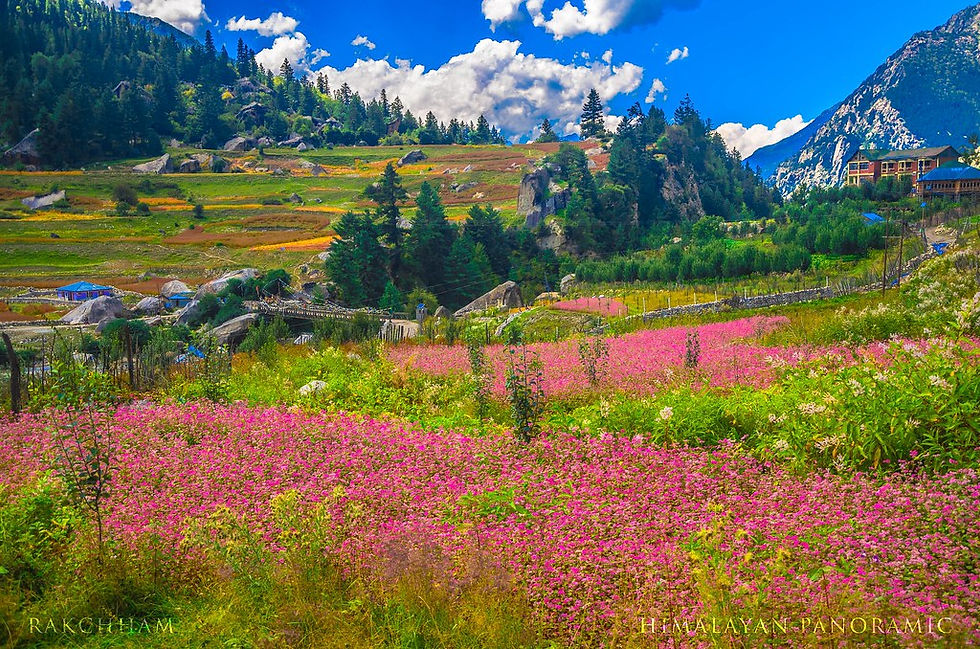Hidden Gems of Dev bhumi
- harish segon

- Feb 15, 2023
- 6 min read
Himachal Pradesh, also known as Dev Bhumi is dotted with hill stations. Tourists mostly visit over crowded hill stations like Shimla, Manali and Kasauli.

Some make it to Sapiti valley, ignoring hidden gems like Kalpa and Sangla in Kinnaur valley. Only a few tourists choose these gems described as land of clouds, snow, and dreams.
Kinnaur is mainly known for its quality, delicious apples. Best quality apples mainly grow at a height of around ten thousand feet. In the year 2009, my son, Ankur, daughter in law, Yogita, grandson Rishabh, who was just six months old, myself and my wife Uma decided to bypass Shimla and spend our vacations exploring inner Himachal and visit Kalpa, Sangla and Sarhand.

We started from Delhi and stopped at Barog, Fagu and Narkanda for a night each. All three are known for their scenic beauty. We had to break journey time and again as Rishabh was too small and needed special attention. Ankur drove our Hyundai I-10 all the way from Delhi.
At Narkanda, we were advised to hire a four by four drive vehicle for onward journey as the terrain is tough, journey little hazardous and tricky. We left our car at Himachal tourism guest house and began second leg of our journey. Road was in bad shape. It was so narrow that two vehicle coming from opposite direction could not cross each other. One of them had to stop in the gap on side of road.

Only local drivers with full knowledge of the road could negotiate tricky curves. The scenery looked like the location of a western movie with winding narrow roads, grey and black rocks jetting out and river Sutlej flowing alongside.
As we climbed higher and higher, we could see chilgoza trees on the sides of river. Though journey up the hill was tiresome, view at the top was breathtaking. The last stretch of journey, a 16 kilometer steep vertical climb of road from Shimla-Kaza highway is instantly rewarded as you get an all-encompassing view of Kinnaur- Kailash mountain range.
Shivling range, sacred to locals is also visible. It changes its colour at different times of the day as light reflects from Shivling. Apple orchards are everywhere. Apple trees and pine woods line up the seven kilometre stretch from Reckong Peo to Kalpa. Apple is the cash crop of the region. Besides apples, area abounds in chilgoza trees, and majestic deodar.
Unlike overcrowded places in Shimla and Manali, Kalpa offers perfect peace and is ideal place for meditation.

We were lucky to get good accommodation at Himachal tourism guest house situated at a vantage point with overview of entire mountain range. Kalpa, at that time, had hardly five to six guest houses.
A Bengali couple, also staying in the same hotel was shocked to see Rishabh in our lap. Ari baba, why have you brought such a small child to this place, they asked.
Kalpa is situated at a height of over nine thousand feet. My reply was, do not worry dada, both his parents are doctors. Kalpa has several temples, which are a mix of Hinduism and Buddhism as Kinnaur people believe in both.

Behind Kalpa Fort, several temples built in Kinnaur style can be seen. A traditional Tibetan Pagoda style architectural beauty sits atop the hills of Chini Village.
Durga Maa takes the throne in Narayan-Nagini Temple. The golden roof shines from far away making it very easy for visitors to find their way.
Another major attraction is Sapni Fort. Raja Padam Singh of Rampur built this ancient fort in 1869. The tower style temple fort was reconstructed in 2014 by joining two buildings together.
The fort is facing the valley for magnificent views. It’s close to Sapni village in the vicinity of Kalpa. The main tower has 7 floors. A grand Kali temple rules the fifth floor with fine woodwork and historical traces.
Kalpa has another first to its credit. First voter to cast his vote in the first general elections in independent India in 1951 -52 was from Kalpa. His name was Shyam Saran Negi, a school teacher. He breathed his last recently at a ripe age of 106.
Kalpa faces severe winter and temperatures drop to -15 degree centigrade in peak winters. The whole valley is covered in white magic with frozen drops of rain falling from the sky. Tall overarching pinewoods are layered in snowy goodness and apple orchards are ever more beautiful.

The staple food in the region is wheat, ogla, phafra and barley which are local produce. Besides these kankani, cheena, maize, chollair and bathu are also taken.
The principal pulses consumed are peas, black peas, mash and rajmash. The vegetables usually consumed are cabbage, turnips, peas, beans, pumpkin, potato, okra and tomato besides some locally available wild green vegetables leaves.
They relish rice too which is imported from the plains. Taking a salted tea called cha in the morning and evening is very popular among the Kinnauris which is usually taken along with Sattu made of parched barley flour.
People, here are non-vegetarian. Taking of alcoholic drinks in their day-to-day life and also on the ceremonial or festive occasions is quite common among them. Alcohol is distilled at the household level.
Our next destination was Sangla, situated at a height of 8900 feet in the Baspa valley, also in Kinnaur district.
Sangla is so famous that Baspa valley is often called the Sangla Valley. Baspa river runs through the valley. The region is blessed with apple orchards, apricots, and walnuts. Cedar trees and fir trees are also speciality of the region.

Sangla is a nature lover’s paradise. Plenty of trout fish is found in the crystal clear glacier water of Baspa river.
Last village before Tibet border is Chitkul, only about 22 kms, from Sangla. Kinnaur Valley is a delight for its cool-calm weather!
Perennially cool, summer months offer the pleasant calm to escape the scorching summer heat of the plains.
In winters, Baspa valley witnesses the beauty of exceptional snowfall and snow-capped mountains.
Sangla temperature in winters fluctuates between -05to -15 degree centigrade. Summer is usually cool and the temperatures average between 10 and 25 degree centigrade.
Sangal Kanda also known as Sangla Meadows, has stunning views of the snow-clad surrounding mountains.
The lush green of the picturesque meadows is a sight never to forget. The gleaming Kinner Kailash in the background enhances the unbelievable experience.
The place is dotted with apple orchards. While reachable by vehicles, the trek is an amazing experience in itself. It is an easy trek and can take 4-5 hours, given your choice of pace, while passing through Rukti Stream to reach a small lake at the top.
Another trek is Rakchham trek. It is fairly easy trek, providing the calmest views, taking you across the glacial streams.

Kamru is the ancient capital of Bashahr principate. The settlement has become especially known for its beautiful tower like fort, which is said to be a few thousand years old.
Locals believe that there are 36 crore deities inside the compound which lies on the foot of Kinner Kailash.
Bering Nag temple in Sangla Valley is a syncretism of the Hindu & Buddhist religions. The temple has amazing architecture and wooden carvings which adds to its beauty.
Fulaich fair is an annual event in Sangla, which happens in the month of August & September. This festival is famous for the celebration of flowers.
While the festival starts with animal sacrifices, it proceeds to wine drinking and serving traditional food to the needy while also collecting flowers from nearby valleys to honor the departed souls. Of course, as is tradition, the festival is celebrated with traditional dances and songs of the region.
Colourful Saffron farms are also worth visiting. The place is riot of colours and a visual delight. Our stay in Sangla was equally rewarding as in Kalpa. We were happy that our little prince Rishabh coped with strain of travel really well.
Our last stoppage was Sarahan. A must visit place enroute is a makeshift dhaba of sorts right after Sarahan where an old lady serves lip-smacking Rajma Chawal.

Yes, the hygiene is slightly questionable, but than, it is a dhaba after-all. The taste is unbeatable.
It used to cost just Rs. 50 for an unlimited plate of Rajma Chawal. That was scenario 14 years ago. I am not sure, if old lady still survives or Dhaba is still there.
Bhimkali temple at Sarahan is dedicated to mother goddess Bhima Kali, presiding deity of the rulers of former Bushehar state. This temple is one of 51 Shakti Peethas in the country.
The Bhimakali Temple contains both Hindu and Vajrayāna Buddhist statues .
There are two adjacent temple buildings. One is old and resurrected, and the other is relatively new. The temple is built in an Kath-Kuni style of architecture.
The King's and Queen's Palaces are comparatively recent buildings adjacent to the temple. Sarahan Bushahr has been the summer capital of Bushahr kingdom, with Rampur Bushahr considered the winter capital.
Our trip to hidden gems of Kinnaur was about to be over. . But we are carrying back memories which we will cherish for ever.
As the trip was coming to end, I was little happy and little sad. I was becoming little philosophical. These mountains were here long before I was born and will be here long after I am gone.
In the mountains, I was struck with the profound feeling of how small and insignificant I am (and we all are). It was a very spiritual feeling and actually brought tears of happiness in my eyes.!




Perhaps those nicknames were born of the brand's relative link youth, surrounded by stony-faced legends of the game whose legacies tower above its own link like the mountains link that cocoon the town from the outside world.
With this PAM339, Panerai pays homage to the link historical link with the Italian Navy, to which Officine Panerai was link an official supplier. In 1998 and 2005, link Panerai created Luminor Marina Militare watches to commemorate this long lasting relationship.
Rolex always comes to mind in terms of customers asking for what's new and hot. Grand Seiko has link made a big splash in the last few years and has really gained momentum as a link desirable alternative to a Swiss timepiece. Hublot has impressed us with their link innovative designs; we love what they're doing.
Which is why I link decided to approach this story a little differently. I don't have my link dive license. I don't run. My exercise routine is sporadic at best. What can I tell you about pushing this product link to the limit that Jason Heaton or DC Rainmaker hasn't already said? So here's my view on the Apple Watch Ultra, through the lens of a traditional watch enthusiast. I've decided to revisit the format used by Ben in 2014, a few days after he handled the original Apple Watch for the first time.
The Vagabondage is an incredibly striking watch link that works the circle-in-square aesthetic better link than most brands. Collectors with link their ears on the ground quickly heard about the watches appearing at auction and began sending requests for Journe to create a broader production model, something the company eventually did one year later, in 2004, while still retaining extremely limited production.